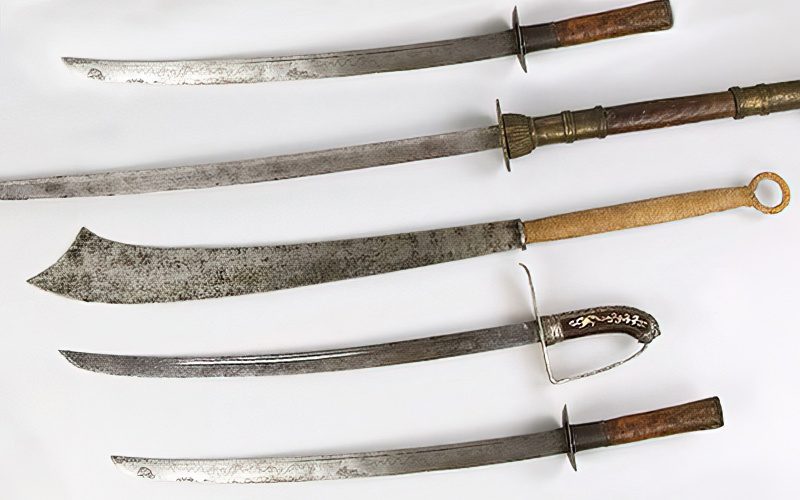Vietnamese Swords
NO AI USED This Article has been written and edited by our team with no help of the AI

Vietnamese swords are edged blades used in regions of modern-day Vietnam. Nestled in the heart of Indo-China, Vietnam has been shaped by its proximity to several powerful dynasties and cultural influences ranging from neighboring China to as far as colonial France. This resulted in a variety of distinctive swords, each with its own story.
This article explores the most popular types of Vietnamese swords, beginning with some of the most historically significant examples and concluding with the lesser-known varieties.
1. Kiem (劍)

The kiem is one of the oldest Vietnamese blades and emerged as early as the Bronze Age. Inspired by the Chinese Jian, they were generally wielded by aristocrats, scholars, and soldiers, symbolizing honor, discipline, and martial prowess. In battle, the kiem are often used in combination with a shield.
- Design: Straight, double-edged blade
- Role: Battle, ceremonial weapon, status symbol
2. Guom (鎌)

The guom or Vietnamese saber’s design is influenced by various cultures including Japanese, Chinese, and European features.
- Blade Design: Gently curved, narrow, single-edged blades. Cross-section can be ridged, wedged, or have a system of fullers / grooves.
- Scabbard: Pointy, reminiscent of Ming China
- Fittings: Often include round or rectangular guards and oval washer—similar to Japanese swords.
- Role: Battle, ceremonial weapon
Depending on their purpose, they may have slightly different appearances.
In his article, Scott M. Rodell, founder of River Taoist Center notes that, “From the 1400s to the 1800s, Vietnamese saber forms followed the political divisions of the country.” He further cited the example of how northern Vietnamese sabers showed a strong Chinese influence.
Tonkin Guom

Similar to a regular Guom, Tonkin Guom are single-edged Vietnamese swords associated with Tonkin, a region in northern Vietnam.
Almost identical to Chinese Liuyedao, they were especially popular between the 13th to 18th centuries, used by both cavalry and infantry. Later, they held military ceremonial roles.
Guom Truong

The two-handed Vietnamese Guom Truong were influenced by Japanese swords like the tachi or katana and the Thai dha. Popular in Central Vietnam, they were used for powerful chopping and cutting attacks.
Generally employed by the military elite, some were especially elaborate for ceremonial roles associated with the military, nobles, and temples.
Thanh Guom

Thanh Guom swords are iconic blades used during the Nguyen Dynasty (1802-1945) for combat, ceremonial purposes, and as status symbols.
Heavily inspired by European saber design, particularly those used in France, most featured a single-edged, slightly curved blade and a knuckle guard for protection.
3. Dao Truong

Dao Truong, meaning “large swords,” are some of the largest Vietnamese swords inspired by Chinese Changdao swords. Although varying slightly in design throughout the eras, the most popular design today is associated with the dadao.
It features a broad blade that flares out with a ridge near the tip, making it ideal for cutting and chopping.
4. Vietnamese Falchions

Hybrid types of falchions were also used in Vietnam. Featuring a leaf-shaped blade with a broad middle tapering towards the tip, it was especially useful as a daily tool such as for cutting through thick vegetation. Some could be reworked blades from swords found in a battlefield.
“…local peasants would find falchions (referring to polearm swords) left on battlefields, pick them up, and reforge them into agricultural tools,” says V. Vetukov, PhD who researched Vietnamese swords.
While some are crude and used by the general public, those with wealthier owners may feature elegant blades with fullers.
5. Yem Nguyet Dao

The Yem Nguyet Dao is a Vietnamese polearm sword inspired by the Chinese Guan Dao or Pu Dao swords.
Used in battle and for martial arts training, it has a broad blade mounted on a long wooden pole. Considered key weapons during the Monarchical period of Vietnam, they were wielded only by the highest-skilled warriors.
6. Dao Gam

Dao Gam are short double-edged swords with a pointed tip. The army depended on these sidearms for melee, grappling, tight-quarter situations, or finishing off a wounded armored enemy.
While some are very simple, others are elaborately designed.
7. Quat
The Quat is another type of Vietnamese sword with significant European influence, especially after the 19th century.
Based on the backsword, the Quat has a straight, single-edged blade and occasional double-edged tip. Some featured basket or knuckle guards.
8. Song Kiem

Song Kiem, meaning “double sword,” are paired Vietnamese short swords with blades similar to a regular kiem. However, its double-edged, straight blades are smaller and may be more elaborately decorated.
They were used for self-defense training, martial arts, entertainment, and ceremonies.
9. Ancient Vietnamese Swords

Some of the first Vietnamese swords were short, dagger-like blades. Like many ancient civilizations, most of these ancient swords were made of bronze or copper with some having elaborately decorated hilts featuring animal or human-shaped hilts.
Most ancient Vietnamese swords are linked to the Dong Son culture (11th century BCE to 1st century AD) and are used for ceremonial and status-defining purposes.




